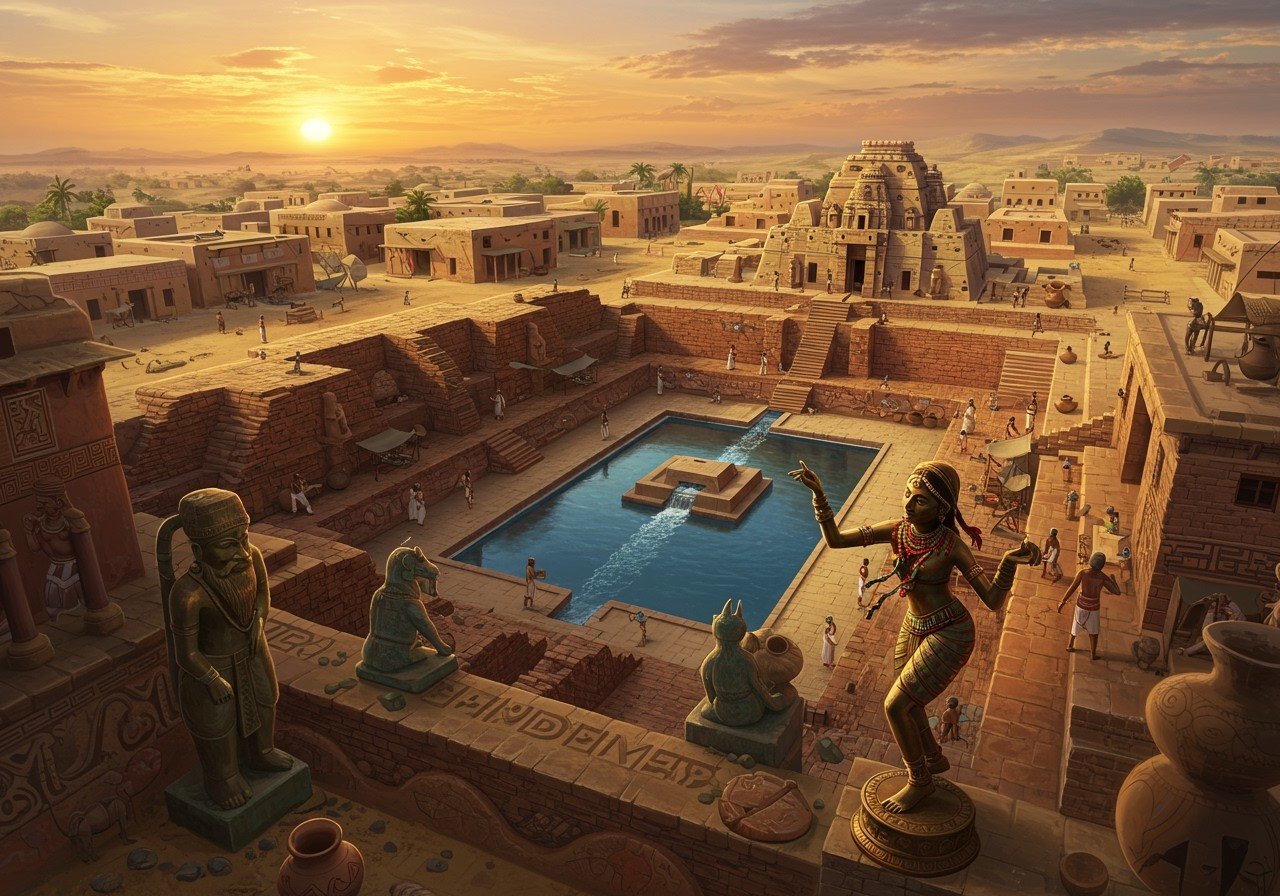
The Indus Valley Civilization, also known as the Harappan Civilization, stands as a testament to human ingenuity in the ancient world. Flourishing from around 2500 to 1700 BCE in the northwestern regions of the Indian subcontinent, this Bronze Age civilization was one of the world’s earliest and most extensive urban cultures, spanning areas from present-day Afghanistan to Pakistan and India. This civilization is renowned for its advanced city planning, sophisticated architecture, unique arts and seals, and remarkable achievements in water management and script. Major sites like Mohenjo-daro and Harappa have yielded significant artifacts such as clay figurines and intricate seals, offering glimpses into the lives of those who inhabited these ancient cities. Though the civilization eventually declined, its legacy continues to be explored and understood through ongoing archaeological excavations and research.
Origins and Discovery
The roots of the Indus Valley Civilization trace back to the early Bronze Age. The discovery of Harappa in the 1920s by archaeologists like Sir John Marshall unveiled a civilization that rivaled those of Egypt and Mesopotamia. River systems, particularly the Indus and its tributaries, played a crucial role in the development and sustenance of the civilization, providing water for agriculture and daily life. The civilization’s geographical extent covered a vast area encompassing modern-day Pakistan and northwest India, showcasing its widespread influence and reach.
Key Cities and Urban Planning
Harappa, one of the major urban centers, serves as a benchmark for understanding the civilization’s sophistication. Notable features include a central fortified area known as the Citadel, large Granaries for storing grains, and well-planned Residential Areas constructed with standardized bricks, demonstrating a high degree of urban planning and organization. Other significant sites include Mohenjo-Daro, famous for its Great Bath, Dholavira with its impressive water conservation systems, Lothal, an important trade center with a dockyard, and Kalibangan, featuring evidence of plowed fields. Common traits across these cities include grid patterns and the use of standardized bricks, highlighting a consistent approach to urban development.
Society, Culture, and Daily Life
The Indus Valley Civilization was marked by a complex social structure and a rich cultural tapestry. Evidence suggests a possible Social Hierarchy with a ruling elite, while Agriculture formed the backbone of their economy, with the cultivation of crops like wheat, barley, and cotton. An extensive Trade network connected them with Mesopotamia and other regions, facilitating the exchange of goods and ideas. Craftsmanship flourished, with skilled artisans producing Pottery, intricate beadwork, and metal objects. Religious Beliefs are inferred from artifacts like seals, figurines, and burial sites, providing insights into their spiritual practices.
The Enigmatic Indus Script
One of the most intriguing aspects of the Harappan Civilization is its undeciphered script. Found on numerous artifacts, the Indus script consists of about 400 distinct signs, often written from right to left. Scholars have proposed various theories, some suggesting connections to Dravidian languages, while others propose links to ancient Sumerian or Elamite scripts. Despite ongoing efforts, the script remains a mystery, hindering our complete understanding of their administration, trade, and daily life. The absence of a bilingual inscription, like the Rosetta Stone, adds to the challenge of deciphering this ancient script.
Mapping the Civilization’s Reach
The Indus Valley Civilization’s influence extended across a vast geographical area. Major sites like Harappa and Mohenjo-Daro are located in modern-day Pakistan, while other significant sites like Dholavira and Lothal are in India. Trade routes connected these cities with distant regions, facilitating the exchange of goods and cultural exchange. Environmental factors, such as river systems and climate conditions, played a crucial role in shaping settlement patterns and influencing the civilization’s development.
Decline and Enduring Legacy
The decline of the Indus Valley Civilization remains a subject of ongoing research. Theories suggest climate change, altered monsoon patterns, tectonic activity, and possible invasions as contributing factors. Evidence suggests a gradual abandonment of urban centers rather than a sudden collapse. Despite its decline, the civilization’s legacy continues to influence modern urban planning and architecture, inspiring contemporary approaches to city design and organization.
Connect With Your Heritage Through Poojn.in
Poojn.in, India’s leading online store for cultural goods and services, offers a unique opportunity to connect with the rich heritage of the Indus Valley Civilization. Explore our collection of authentic and handcrafted items:
- Copper and Bronze Vessels: Discover beautifully crafted vessels reminiscent of those used in ancient Harappan times, perfect for adding a touch of history to your home.
- Traditional Clay Pottery: Explore our collection of handcrafted clay pottery, reflecting the artistry and craftsmanship of the Indus Valley Civilization, ideal for both decorative and functional purposes.
- Sacred Items for Rituals: Find a wide range of sacred items for traditional rituals, allowing you to connect with the spiritual practices of your ancestors and maintain age-old customs.
- Handcrafted Items: Discover a diverse selection of handcrafted items made using traditional techniques, showcasing the artistic skills and cultural heritage of India.
Visit Poojn.in today to explore our complete collection and bring a piece of India’s rich history into your life.
Further Exploration
Delve deeper into the fascinating world of the Indus Valley Civilization with these insightful articles:


